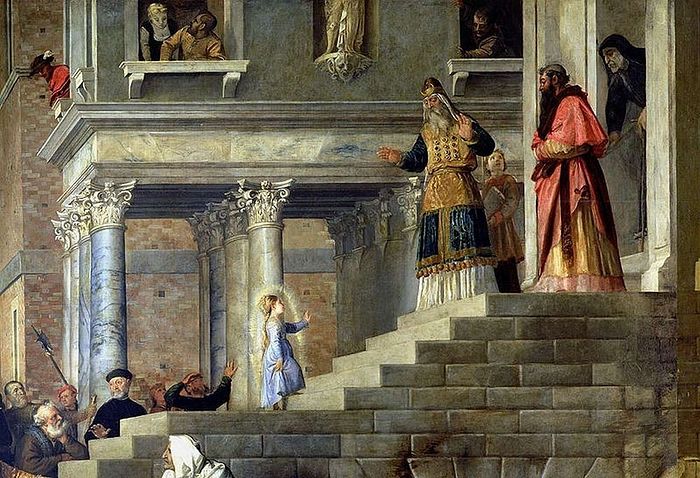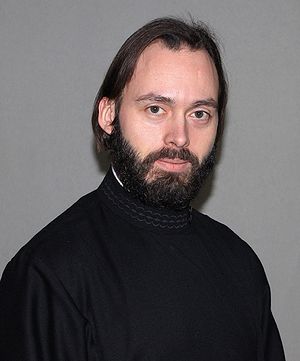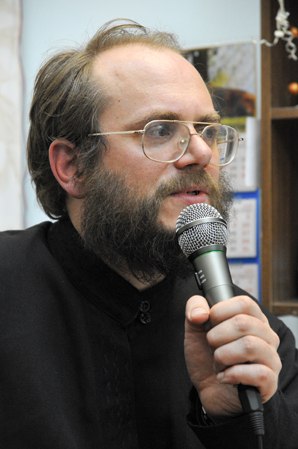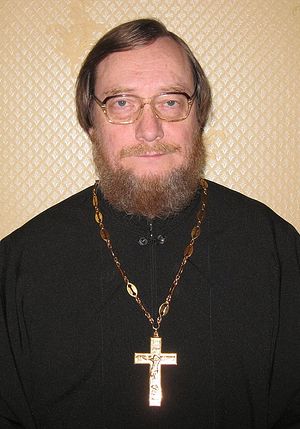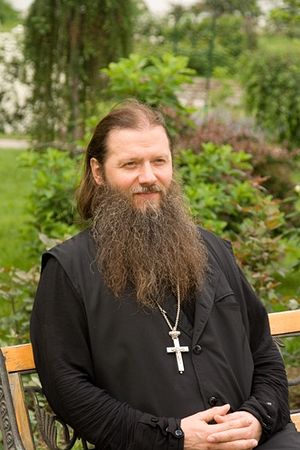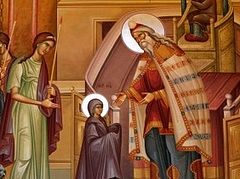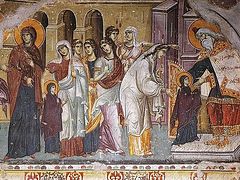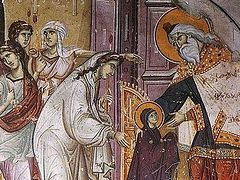The Entrance into the Temple of the Most Pure Virgin Mary is a great Church feast, and a miracle for all Orthodox Christians. The three-year-old girl ascended the tall steps of the Temple without any help from others, entered the Holy of Holies—the sacred place where no one but the high priest could enter, and at that only once a year. Isn’t this a miracle? However in our skeptical times even some Christians place this event under doubt. Priest Valery Dukhanin, Deacon Vladimir Vasilik, Archpriest Andrei Khvilya-Olinter, and Archpriest Artemy Vladimirov talk about why this happens.
“The Church, moved by the Holy Spirit, trusts in this event as a fact.”
Priest Valery Dukhanin, doctoral candidate in theology, dean of the St. Nicholas Ugresh Theological Seminary:
In the history of human salvation everything is unique and inimitable. For example, let’s recall something from the Gospel. The unwedded conception of Christ and His virginal birth, the appearance of God the Trinity at the Savior’s Baptism and His illumination with divine light on Mt. Tabor, the Resurrection after three days and the Ascension—all of these events took place only once in history and were never repeated. These events lay at the foundation of Church feasts. And the life of the Most Pure Theotokos, who served the mystery of man’s salvation, also has unique and unrepeated events.
The entrance of the Most Holy Virgin into the Holy of Holies of the Old Testament Temple in Jerusalem is an exclusive, extraordinary event. The tiny, three-year-old Virgin Mary is lead into the Holy of Holies, because she herself has been fashioned by God as the Holy of Holies. She is the holiest person out of all mankind, and only she was vouchsafed to become the Temple of God Who came and abode in her.
The high priest who received the small Virgin Mary and allowed her into the Holy of Holies was in this instance not motivated by mere human feeling, but by the special action of God. He took a step that he could never have taken by human means—after all, he was forbidden to allow anyone into the Holy of Holies. But since this little girl happened to be the most pure person in the world, who completely dedicated herself to God, what happened in the Temple was subject not to human calculation, but to God. That is, the Entry of the Mother of God into the Holy of Holies is a particular, providential act of God.
Our times are overly rationalistic. Much is subjected to criticism and doubt. The entry of the Virgin at age three seems untenable by virtue of the fact that it does not fit into the framework of scientific thought.
If you proceed from ordinary human history, then yes, it is logical—after all, only the high priest entered the Holy of Holies, and that only once a year. But the Gospel, in fact the whole of human history witnesses to such a phenomenon as miracles. A miracle is a particular act of God, which in no way corresponds to the laws of life that we are used to. That is why hopelessly sick people are healed, unsolvable life situations are solved after sincere and fervent prayer—because God acts. Could we really think that God Who made the Most Holy Virgin the living temple of God, Who prepared her to become the Mother of Heaven and Earth, could not perform such an act as the Entry of the Most Holy Virgin into the Temple? How many miracles were wrought in Gospel history—miracles that clearly contradicted the desires and traditions of the Jews, and we think that miracles related to the Mother of God should not contradict the ancient Jewish Temple traditions?
The ancient tradition of the event of the Entrance was fixed in the apocryphal Protoevangelium of James, written in the second century A.D. That is, the Christians of the first centuries knew perfectly well about this event. The Apocrypha were not accepted into the canon of sacred books, but in them was partially fixed true Church tradition. In the Apocrypha was preserved very much about the Mother of God. And that the Church included the event of the Entrance in the cycle of the main feasts shows that the Church, moved by the Holy Spirit, trusts this event as a true fact in the history of mankind’s salvation. The bare reason upon which scholars rely often betray them, and therefore in scholarship, one version is often replaced by another. This is an alien view, external and therefore foreign to the Church. If we believe that the Church is the pillar and foundation of the truth (1 Tim. 3:15), then we should accept the Church’s testimony about events connected with the life of our Lord Jesus Christ and His Most Pure Mother as truth.
***
“Skepticism is possible were there is no faith”
Deacon Vladimir Vasilik, doctoral candidate in linguistic sciences, docent of the history department of St. Petersburg University, docent of Sretensky Seminary.
A three-year-old girl stands before the enormous fifteen-step entranceway of the Jerusalem Temple. Even a healthy adult would have trouble climbing them. But little Mary ascends them without any outside help. Is it a miracle? Yes. But this is only the beginning of the miracles that would finally lead to the greatest miracle in world history—the redemption of mankind by her Son, the Resurrection of Christ, and our co-resurrection with Him.
In order for this to become possible, the Virgin Mary had to go through a spiritual school in the Temple of the Lord—to stand before the great and Holy Lord—the school of holiness and sanctification. Therefore it is natural that St. Zachariah, the father of St. John the Baptist, led her into the Holy of Holies. Some researchers and skeptics will say that this is not possible, that women were never allowed into the Temple and especially not into the Holy of Holies, where only the high priest had the right to go, and that only once a year. But “where God so wishes, the order of nature is overthrown.” Against the background of the great miracle of the virgin birth of the Savior, don’t other miracles become just as plausible, including the ascent of the Most Pure Virgin into the Holy of Holies? It shows that man was not made for the Sabbath but the Sabbath for man, that the Temple is not self-sufficient, but called to serve for man’s salvation. For The Most High does not dwell in temples made by man. As the Creator of an enormous, harmonic and complex universe, He does not need a temple for His habitation. More than that, it is not He Who lives in the world, but the universe that lives in Him, is moved by Him, and exists through Him. And if the Most Pure Virgin must become the Chamber of the Uncontainable One, and greater than the Holy of Holies, then it is no surprise that she was led under the wings of the cherubim, if she is “More Honorable than the Cherubim and more glorious beyond compare than the Seraphim?” Skepticism is only possible where there is no faith, but where there is faith, “all is possible in Jesus Christ Who strengthens us.” To Him be glory unto all ages. Amen.
***
“The Tradition of the Church is not subject to any doubt”
Archpriest Andrei Khvilya-Olinter, Deputy Head of the Internal Affairs Synodal Department of the Moscow Patriarchate sector for Relations with the Armed Forces and Law Enforcement Agencies, candidate of Legal Sciences, docent of St. Tikhon’s Orthodox University for the Humanities, docent of the Ministry of Internal Affairs of Russia Academy:
Our joy fills our entire soul and whole heart at any word about the Most Holy Theotokos, and the miracles from her are endless. Among them is, undoubtedly, the Entrance of the Most Holy Theotokos into the Temple. The Old Testament already recognized the Theotokos in the face of the righteous, and the Temple received her. Everything is from God, through God, and in God!
I, a sinful priest, in my little personal experience, testify of the reality of the miracles of the Most Holy Theotokos, and I know a number of concrete people, faithful children of the Church, who also bear witness to the miracles revealed to them. But these are purely personal and intimate circumstances. You can, and sometimes should doubt them.
However, the sacred Tradition of the Church is something wholly other. It is not to any doubt. Everything here is extremely serious, because it is connected with the salvation of man, with the meaning of his life, with his high calling on earth and in eternity. O Timothy, keep that which is committed to thy trust, avoiding profane and vain babblings, and oppositions of science falsely so called: Which some professing have erred concerning the faith (1 Tim. 6:20-21).
The great twentieth-century theologian Vladimir Nikolaevich Lossky writes, “Tradition is the life of the Holy Spirit in the Church, life, communicating to each member of the Body of Christ the faculty of hearing, of receiving, of knowing the Truth in the Light which belongs to it.”[1] In this way, Holy Tradition is not just the transmission of experience, or the handing-on of knowledge, and not even the transfer of grace, but it is the ability given to us to listen, to feel, and to understand this grace, including through miracles..
The path of Orthodoxy is the way of life of faithful Christians (the apostles, their disciples, and so on, until the present and future times), because only Orthodoxy has preserved and maintains what was received from God, neither adding, not altering, nor subtracting anything from its substance arbitrarily. The fundamentals of Orthodox Tradition are not just in the past, but they are in the present and the future—they are beyond time and changes, outside and above this world. And here traditionalism is not an end in itself, and not a stagnation, but an expression of loyalty and love, of unity of spirit and faith, a guarantee of the preservation of the truth of religion and the genuine freedom of the individual. There were always miracles in the Church, there always are, and there always will be.
In the modern, vain, neo-liberal, neo-pagan, anti-Christian world, even among those who consider themselves Orthodox, you can find skeptics, not accepting Orthodox miracles, but reveling in all kinds of “fantasies.” These spiritual illnesses always arise from pride, greed, or cowardice. Such people themselves place a barrier between God and themselves—doubting everything holy. In the end, they are at the mercy of spiritual lawlessness: If a man also strive for masteries, yet is he not crowned, except he strive lawfully (2 Tim. 2:5); depart from me, ye that work iniquity (Mt 7:23). The end of such a life is sorrowful, but it is their free choice.
***
“You ask me, why to write in verse
Of that which all know so well?”
Archpriest Artemy Vladimirov, senior priest and confessor of St. Alexis Convent, teacher at St. Tikhon’s Orthodox University for the Humanities and Russian Orthodox University, member of the Union of Russian Writers:
To begin with, I would advise so-called skeptics to acquaint themselves with the service of the Entrance and to imbibe not only its high poetry, but also the spiritual content of the event celebrated.
If the Creator was pleased to give aid in the Most Pure Mary’s appearance into His world, then why should the power of the Spirit not come to fruition in the present event? And again, St. John Chrysostom recommends never to ask the question, “How could this be?” when speaking of the providence of God, and about the mysteries of the salvation of mankind. But much more useful is it to contemplate the inner meaning of what is occurring, thus I have tried to do so in poetic form:
The Entrance into the Temple
1
You ask me, why to write in verse
Of that which all know so well?
And what earth and ashes, dust and dirt
About the love of Heaven can tell?
“Known, but not by all,” say I to my chums,
But perchance by these lines
I will help a soul to the Church to come
and meet her whom he did not seek to find…
Yes, dust and ashes neither speak nor sing,
But believe me, they have fear,
Although to the valleys and gorges they cling,
But before the stars they revere…”
2
For her appearance the earth awaited the hour
Worn out from the centuries passed,
Like a scorched field awaits a shower,
In the cool drops taking its repast.
By every child into the world does light come
Shining with purity and innocence,
Of those who love them not, let there be none,
For beautiful children know not wickedness…
But she who the name of Mariam received,
Is like the earth’s illumining by celestial light.
For her feelings, words, and deeds
Were imbued with Divine might.
Grace is exuded by Mary’s soul,
By her smile all sorrows are destroyed.
To her chest the Child she gently holds,
This mother of playful spirit finds joy.
By her parents God is impressed to give
Mary to the Temple at the age of three.
For the altar was to be where she would live,
Where on angelic manna she did feed…
3
And there came the bright and farewell day,
And the aged Joachim and Anna
Led the child under the Temple’s shade,
And virgins followed and sang “Hosanna…”
From the terrace marvels God’s priest,
As up the stone steps making her way,
Maria her mother and father behind her leaves,
Ascending to God with spirit aflame.
There, abiding beyond the purple veil,
With Gabriel’s legation she was blessed…
From the angel of the joyous news she heard the tale,
Submissively bowing her head to her chest…
4
But the feast has a spiritual sense,
Worthy only of a radiant mind:
Also prepared for an entrance
Into the temple of the heart—the meaning to find
Given to those who attentive prayer love.
Shining into the heart by tiny candlelight,
By the mind, like a brush, with palette from God above,
Taking cinnabar and minium with turquoise, colors bright,
Believers paint on the Temple walls
Humility, purity, and love…
As the angel brought joy to Mary by his call,
The Lord’s Spirit overshadowed the Virgin from above.
So a disciple of Christ, in prayer enlightened in mind
By the invisible power of the Divine,
Like weeping willow at the feet of Christ inclined
Enriched with knowledge of the Creator sublime…
5
I’ve exhausted, friends, today’s word,
Powerless these mysteries to convey,
Of course nothing new here you’ve heard:
They are proclaimed by God’s grace
In the services through prayer and song,
The writings of holy men.
But if some verses into your soul come,
As a fragrant flower to her offer them,
To the humble Virgin O most blessed,
As from our simplicity a tiny gift,
And her incorrupt omophor kiss and caress,
Placing the verses into her lily fist…

